As a newcomer to Italy, using public transport in Italy can be a challenge. We’ll share valuable tips and resources to help you navigate public transport with confidence, making your life in Italy more enjoyable and stress-free.
Understand the Local Italian Transport System
Familiarize yourself with Italy’s transport system, including buses, trams, and trains. In Rome, for instance, the ATAC website and app offer valuable information on routes, schedules, and ticketing. For other Italian cities, check the respective local transport websites or apps.
Save Money with Transport Passes
Consider purchasing a transport pass to save money and make traveling more convenient. In Rome, the Roma Pass or Integrated Time Ticket (B.I.T.) grants unlimited access to the public transport network. Similarly, other cities offer passes tailored to their specific transport systems.
Embrace Italy’s Train Network
Trains are a popular way to travel across Italy. Look into Trenitalia and Italo passes for the most suitable option based on your route and travel frequency. Both companies offer a variety of ticket options, catering to diverse travel needs.
Utilize Navigation Apps
Google Maps and Moovit are excellent apps for navigating public transportation in Rome and other Italian towns. They offer real-time information, route planning, and travel time estimates.
Be Mindful of Transport Schedules
Be aware that public transport services may have limited schedules during holidays and local festivals. To avoid delays, always check timetables in advance and plan your trips accordingly.
For instance, the ATAC website and app in Rome give useful information about routes, timetables, and ticketing. For unrestricted access to Rome’s public transportation network, you can purchase a Roma Pass or an Integrated Time Ticket (B.I.T.) in there. These passes might help you save money and make your journey more convenient.
When traveling across Italy by train, consider purchasing a Trenitalia or Italo pass, depending on your route and frequency of travel. Both firms provide a choice of ticket alternatives to meet your specific requirements.
Learn Basic Italian Phrases
While many Italians speak English, it’s helpful to learn a few basic Italian phrases for better communication. This skill will be particularly useful when asking for directions or assistance with public transport.
Simple phrases like “Buongiorno” (good morning), “Grazie” (thank you), “Quanto costa la tariffa?” (How much is the fare?) can go a long way.
Keep an Eye on Your Belongings
It’s no secret that you can be a victim of pickpocketing in Italy. As with any public transport system, it’s essential to keep an eye on your belongings and be vigilant. Be cautious and mindful of your surroundings, especially in crowded areas.
Embrace the Local Culture
Be patient and embrace the Italian way of life, which may sometimes include delayed public transport or strikes. Enjoy the journey, and don’t forget to strike up a conversation with locals to make your experience more authentic and enjoyable.
For more travel inspiration in Italy or legal advice to move here, be sure to check out our blog and our social gatherings happening in Rome for when you need a break from the crowded places! You can also email us at [email protected].
Don’t forget to check out our Social Media accounts and subscribe to our Newsletter so you can be updated with information customized for people that want to move, live and love Italy!
FAQs for Italian citizenship by Marriage (2023)
Understanding the Tessera Sanitaria: Your Italian Health Insurance Card
Non-Married Partners: How to Obtain a Residence Permit in Italy as De Facto Cohabitants
How to get tax identification number for foreign citizens (Codice Fiscale)
How to register in Italy as a EU citizen
Mastering Public Transport in Italy
The Advantages of Dual Citizenship with an Italian Passport: Unlocking Boundless Opportunities
What you need to know about Visas and Permits to stay in Italy
Explore All the Exciting Things to Do in Rome and Italy this May, from the well-known attractions to hidden gems!
Welcome, expats living in Rome and Italy! You’ve made a fantastic decision to call this beautiful country home. We’ve compiled a list of the best things to do and the events happening in May to help you immerse yourself in the local culture. And, for those who are new to public transport in Italy, we’ve got you covered with some handy tips to make your travels stress-free.

May 1st: May Day Celebrations in Rome
May 1st is a national holiday known as International Workers’ Day, or May Day, which is widely celebrated across most European countries, similar to Labor Day.
Romans particularly enjoy this day as an opportunity to spend time outdoors, indulging in picnics or leisurely lunches with friends and family.
Here’s a list of what’s closed and open on May 1, 2023, in Rome:
Closed on May 1, 2023:
– Vatican Museums and Sistine Chapel
– Capitoline Museums
– Castel Sant’Angelo
– Ostia Antica
Open on May 1, 2023:
– Colosseum, Roman Forum, and Palatine Hill
– Galleria Borghese
– Saint Peter’s Basilica (as well as other churches)
– Galleria Doria Pamphilj
– The Pantheon
Tip: Take advantage of the holiday to explore Rome’s iconic sites and immerse yourself in the city’s vibrant atmosphere.
Primo Maggio Concert: A Celebration of Music in Rome
Start your May adventure with the annual Primo Maggio Concert held in Piazza San Giovanni. This free, open-air event features a diverse lineup of Italian and international artists. It’s an ideal opportunity to socialize with locals, dance the night away, and immerse yourself in Rome’s vibrant music scene.

Rome’s Secret Gardens: The Perfect Escape
Tired of the tourist crowds? Venture off the beaten path and discover Rome’s hidden parks. Villa Doria Pamphili, Villa Ada, and Parco degli Acquedotti offer serene settings for a relaxing picnic or leisurely stroll, allowing you to recharge amidst lush greenery.

Rome’s Blooming Roseto Rose Garden on Aventine Hill
The picturesque Roseto Rose Garden, nestled on the Aventine Hill in Rome, opens its gates to the public from April 21st through early June. In recent years, the garden has also been reopening for a couple of weeks in mid-October.
However, May is the ideal time to visit, as the roses reach their peak beauty, showcasing their magnificent full blooms. Not only is entry to the Roseto Rose Garden free of charge, but it also tends to be relatively uncrowded, making it the perfect serene escape amidst the bustling city.

Open House Roma
Hundreds of palaces, palazzos, ruins, and monuments in and around Rome are free to explore in May.
The dates for Open House Roma in 2023 are May 20-28.
Visit a variety of homes ranging from modern to old. The site is only in Italian, but you can view photographs of the numerous spots you may visit, and if you click on any of them, a map of their location will appear.
The Street Art Scene in Rome: A Visual Feast
Rome’s thriving street art scene adds a modern touch to the ancient city. Explore neighborhoods like Ostiense, Pigneto, and Tor Marancia to uncover striking murals, thought-provoking installations, and captivating graffiti. It’s a unique way to experience Rome’s contemporary culture.
Food Festivals: A Culinary Adventure
Food lovers, this one’s for you! May is the perfect time to indulge in Rome’s food festivals. Sample traditional Roman dishes at the Cacio e Pepe Festival or treat your taste buds to artisanal gelato at the Gelato Festival. These events provide a wonderful opportunity to savor Italy’s culinary delights and mingle with locals.
Night of the Museums: History Comes Alive
Witness Rome’s rich history in a new light during the Night of the Museums. This exclusive event allows you to explore Rome’s museums and cultural sites after dark, with many locations hosting special activities and performances. It’s a magical experience that shouldn’t be missed.
Check this list of participating museums: Capitoline Museums, Centrale Montemartini, Mercati di Traiano – Museo dei Fori Imperiali, Museo dell’Ara Pacis, Museo di Roma, Museo Napoleonico, Museo di Roma in Trastevere, Museo Pietro Canonica a Villa Borghese, Musei di Villa Torlonia (Casina delle Civette, Casino Nobile, Serra Moresca), Museo delle Mura, Museo Carlo Bilotti – Aranciera di Villa Borghese, Museo di Scultura Antica Giovanni Barracco, Museo Civico di Zoologia, Museo della Repubblica Romana e della memoria garibaldina, Galleria d’Arte Moderna, Museo di Casal de’ Pazzi and more.
There will be a lot of concerts and special performances and events happening in Rome too!
For the full list of the participating museums and sites, check out museiincomuneroma.it
Assisi’s Calendimaggio Festival: A Medieval Journey
Just a couple of hours away from Rome, the enchanting town of Assisi hosts the Calendimaggio Festival. This lively event celebrates the town’s medieval heritage with colorful parades, captivating theatrical performances, and traditional music. It’s a unique opportunity to step back in time and experience Italy’s rich history.

Giro d’Italia: A Thrilling Cycling Race
Witness one of the world’s most famous cycling races, Giro d’Italia, as it winds its way through Italy’s breathtaking countryside. Join locals in cheering on the cyclists and soak up the electric atmosphere. Check out the official website to get all the information and plan for your adventure!
The International Kite Festival in Cervia: A Sky Full of Colors
For a family-friendly day trip, head to the coastal town of Cervia for the International Kite Festival. This vibrant event showcases stunning kites from around the world, alongside flying displays and kite-making workshops. It’s a fun and unforgettable experience for all ages. Check the website for more information!
The Open Cellars Event: A Toast to Italy’s Wine Culture
On the last weekend of May, wineries across Italy open their doors to the public for the Open Cellars event. Embark on a scenic road trip through the country’s picturesque vineyards, sample exquisite wines, and learn about the winemaking process. This event is perfect for wine enthusiasts and those looking to explore Italy’s countryside.
Tips for Expats and Tourists Visiting Italy in May
Dress for the Weather and Cultural Norms
May in Italy brings pleasant temperatures and the beginning of the summer season. Pack lightweight, breathable clothing and comfortable walking shoes for daytime explorations. However, it’s essential to respect cultural norms, especially when visiting religious sites. Ensure you have a shawl, scarf, or a light jacket to cover your shoulders and wear modest clothing that covers your knees when entering churches or other sacred places. Don’t forget to pack a light rain jacket or umbrella, as May can occasionally bring showers.
Familiarize yourself with the local and regional transport system
To understand the schedule and routes for buses, trams, and trains in Italy can be tricky at first. Check out every city public transport website beforehand!
For example: Rome’s ATAC website and app provide valuable information on routes, schedules, and ticketing. You can purchase a Roma Pass or Integrated Time Ticket (B.I.T.) for unlimited access to Rome’s public transport network. These passes can save you money and make traveling more convenient.
When using trains to travel across Italy, consider purchasing a Trenitalia or Italo pass, depending on your route and travel frequency. Both companies offer a variety of ticket options to suit your needs.
Google Maps and Moovit are great apps to help you navigate public transport in Rome and other Italian cities. They provide real-time updates, route planning, and estimated travel times.
Keep in mind that some public transport services may have limited schedules during May holidays and local festivals. Always check timetables in advance to avoid delays.
Learn Basic Italian Phrases and Local Customs
While many Italians speak English, learning some basic Italian phrases will make your interactions with locals more enjoyable and help you navigate public transportation and restaurants more easily. Simple phrases like “Buongiorno” (good morning), “Grazie” (thank you), and “Dov’è il bagno?” (where is the bathroom?) can go a long way. Also, familiarize yourself with Italian customs, such as greetings, dining etiquette, and tipping practices, to ensure a smooth and culturally respectful experience.
We can help you with a free Italian lesson to get you ready for your next adventure in Italy!
In conclusion, Rome and Italy offer a wealth of exciting events, hidden gems, and unforgettable experiences for expats in May. With our comprehensive guide and public transport tips, you’ll be well-equipped to make the most of your time in this captivating country. Embrace your new home, and happy exploring!
Don’t miss out on our latest updates and legal advice for expats in Italy. Check out our Social Media accounts and Newsletter so you can join us in the next Social Meet-ups for Expats!
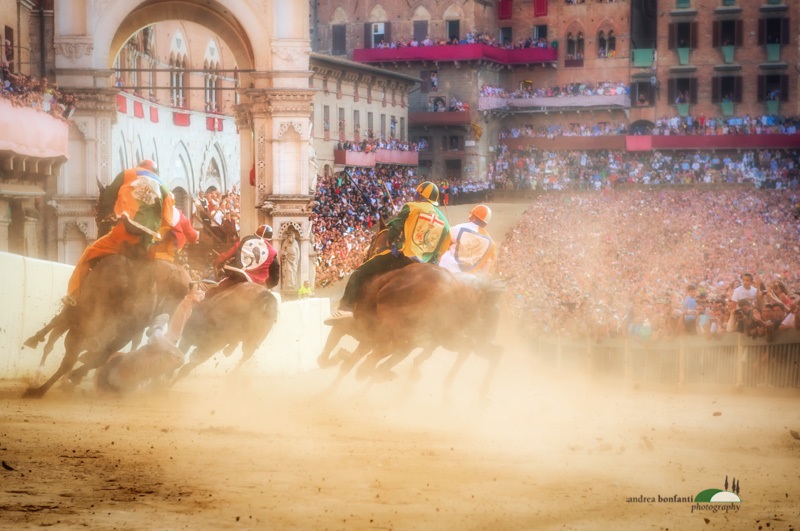
The Palio dell’Assunta: Siena’s Historic Horse Race
The Palio dell’Assunta in Siena is a historic and vibrant horse race held annually on August 16th. This event, deeply rooted in medieval traditions, takes place in the picturesque Piazza del Campo. It is one of the two Palios held in Siena each year, the other being the Palio di Provenzano on July 2nd. What […]

Ferragosto in Italy: What It Is and How It’s Celebrated
Ferragosto, celebrated on August 15th, is a significant public holiday in Italy that marks the height of the summer season. This ancient holiday has deep roots in Roman history and is a time when Italians come together to enjoy festive activities, travel, and communal gatherings. Understanding Ferragosto provides a window into Italian culture, traditions, and […]
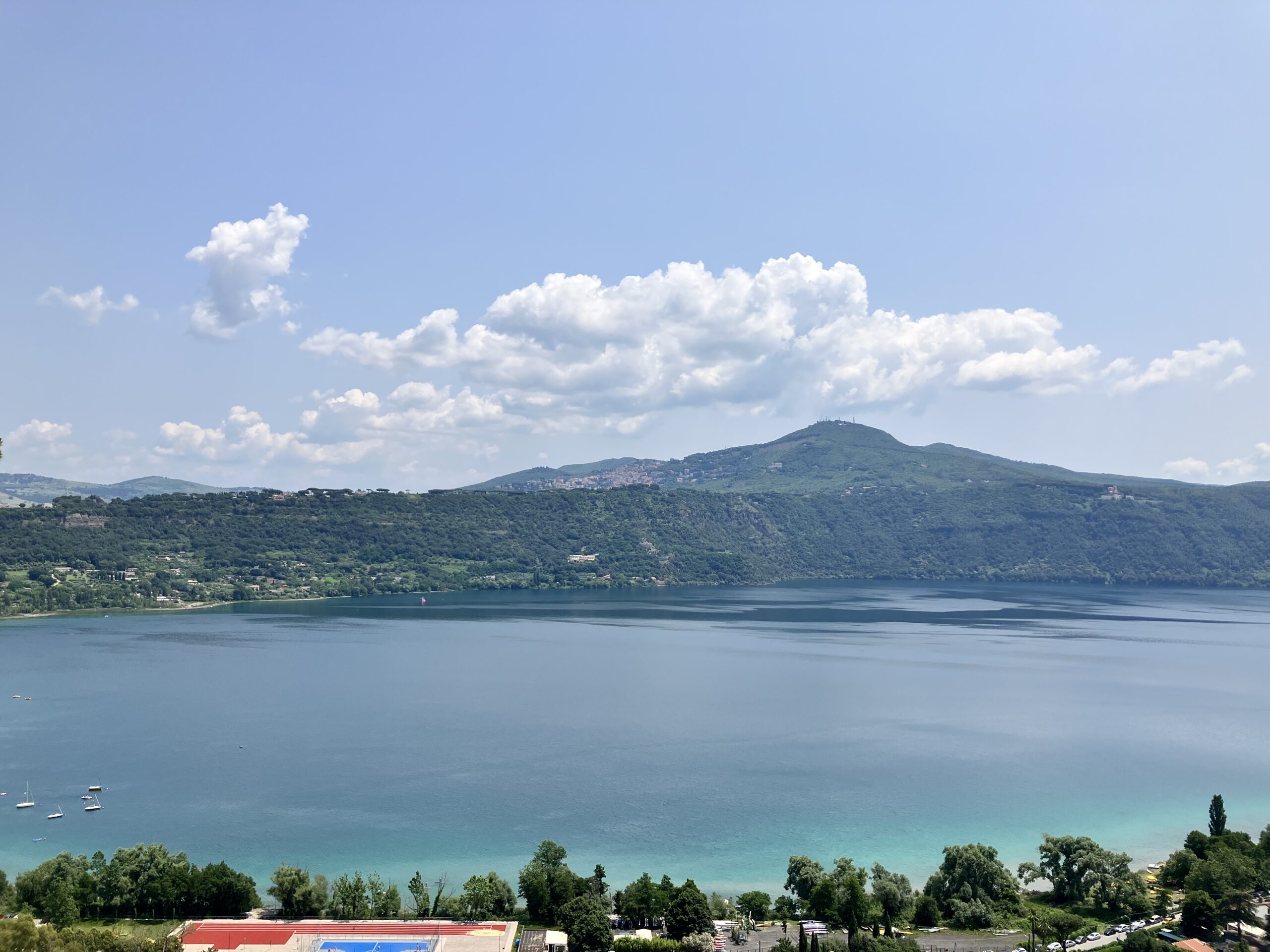
Explore The Roman Countryside: A Summer Hike In Castel Gandolfo
Guest Article written by Sal from Nature of Sal For a refreshing escape from the city heat, expats can explore the picturesque trails of Castel Gandolfo. Nestled in the Alban Hills, this charming town offers stunning views and a serene hiking experience. Discovering Castel Gandolfo Castel Gandolfo is famous for its papal palace (after all, […]
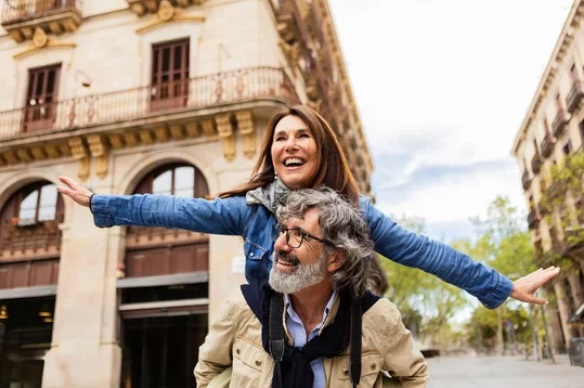
How to Benefit from Italy’s 7% Tax Rate for Foreign Pensioners
Optional Regime for Foreign Pensioners – What It Is Overview Individuals receiving pension income from foreign sources who transfer their tax residence to Italy can benefit from an optional tax regime. This regime is available to those moving to specific municipalities in Sicily, Calabria, Sardinia, Campania, Basilicata, Abruzzo, Molise, and Puglia, with populations not exceeding […]

Staying Hydrated On Summer Hikes: Essential Tips For Expats
Guest Article written by Sal from Nature of Sal As the temperatures soar in July, staying hydrated becomes crucial for hikers in and around Rome. For our community, understanding how to maintain proper hydration is key to enjoying safe and enjoyable hiking adventures. Hydration Tips for Summer Hikes – Drink Plenty of Water: Start […]
Previously, Legal help for Expats published this post on how to acquire Italian citizenship. If you’ve read it and realized that CITIZENSHIP AS A RESULT OF ITALIAN PARENTS/ANCESTORS (“ius sanguinis”) is your case, then here are the complete instruction on how to proceed:
The procedure to apply for jure sanguinis citizenship can be carried out at the Italian Consulate in a foreign country where the applicant resides, or in Italy.
(Art. 1, Law No. 91/1992)
If the citizenship application process is filed in Italy, you might need to move to Italy for the duration of the procedure (in order to be available in case public administration requires it; you can process it or delegate the process)
Immediately after your arrival in Italy, you must declare your presence in the country (“dichiarazione di presenza”) at the Municipality where the procedure will be carried out indicating your residence address. Then you must appear in person before the “Prefettura” with appointment to get your paperwork checked.
Duration of citizenship recognition under administrative law is not predictable at all, since 2018 the Italian Government has established that Public Administration has 4 years to decide on said requests.
The procedure
To apply for jure sanguinis citizenship the applicant must show that he/she has an Italian ascendant and that the citizenship chain has not been interrupted or lost.
You must gather all the required documentation: birth, marriage and death certificates of all ascendants in the same line of kinship up to the applicant applying for citizenship; certificate stating “the absence of loss of Italian citizenship” by the Italian ascendant (e.g.: a letter from a State Public Department such as an Electoral Office or the National Naturalization Record stating that the ascendant never acquired citizenship in any other Country to which he/she emigrated, i.e. and did not lose or renounce Italian citizenship.
The Electoral Office shall certify, that the person never appeared on voting list). Otherwise, if the Italian ascendant has lost or renounce citizenship their Italian citizenship, the applicant must present certificates showing that citizenship was lost after the descendant’s birth, who has acquired the right to citizenship and continues with the citizenship chain.
Example of the right chain of transmission:
- marriage of ascendant A with B
- birth of ascendant C (son of A + B)
- death of ascendant A
- marriage of ascendant C with D
- birth of ascendant E (son of C + D)
- death of ascendant C
- marriage of ascendant E with F
- etc. ... following the chain up to the applicant for citizenship (you)
Each descendant must have been born before the death of his or her direct ascendant.
It does not matter if at any point in his/her life that ascendant A (only Italian citizen of the chain) has lost citizenship, what does matter is that his/her child (C) was born before they lost their citizenship of A.
All certificates issued by foreign Authorities must be legalized and translated by a sworn translator. Legalization is an administrative procedure by which validity is granted to a foreign official document, verifying the authenticity of the signature and the capacity of the signing authority (e.g.: in the case of the UK, USA, Spain or Argentina a document is legalized by apostille). This means that certificates must be legalized only in case they are issued by Official Organizations.
A common question is “does the Apostille expire?”
The Apostille does not have an expiration date, and valid as long as the document is still valid. Birth, marriage or death certificates issued in Argentina and in Italy that are legalized, authorized and apostilled have no expiration date; certificates issued in Spain are valid for three months. Therefore, we suggest that you check with the registry of your own country, or even better, in the city or town where the citizenship process is carried out to avoid expired documentation. Which can delay your process.
Old certificates often present many errors (typos, names do not match, birth dates are not correct, etc.). As a result, doubts could arise about the identity of the person in question. In such cases you can request the corresponding Official Department to rectify the document or to issue a certificate stating that the identity of one person indicated in two different documents is the same.
The “1948” case
In the case of jure sanguinis citizenship by female ascendant, when one of the ascendants is a woman and her descendant was born before 1948, a trial must be initiated before the court with jurisdiction in Rome in order to carry out the necessary procedures.
In common language this is known as the “1948” case.
In 1948 the Italian Constitution established the principle of equal rights between men and women. As there are still legal gaps in some areas of the Italian legal system (including citizenship), a judge’s ruling is necessary for the Court to recognize citizenship.
The duration of the trial can last from 1 to 3 years.
A power of attorney is required to start the trial
In order to avoid any dispute that may delay and/or block a trial, when the applicant can’t sign the power of attorney in person before the lawyer in Italy, we recommend the issuance of a public deed. However, power to act can be granted by private instrument certified by a notary public. In this second case, as established by the Italian Supreme Court of Appeals (rulings nº 22559 of November 4, 2015; nº 12309 of May 25, 2007; n. Of May 5, 2006, etc.), the following is essential:
1) the power of attorney must be signed in the presence of a notary public;
2) the Notary public must have verified the identity of the parties;
3) points 1) and 2) must arise from the declaration of the notary public attached to the deed.
Minors must be represented by the child’s parent or legal guardian. You should check with the notary public in your country which formalities must be fulfilled in such a case.
FAQ:
– When in the same family line there are several descendants interested in obtaining citizenship, one single process (parental trial) can be initiated. Legal representation shall be collective and simultaneous and, as a result, costs shall be reduced.
– The procedure can be followed using the smartphone app “Giustizia Civile”. The app allows checking all the ever-changing circumstances of the trial – except for the name of the parties and the lawyer due to privacy reasons.
– According to Italian law, a child under 18 years old who has already acquired citizenship automatically acquires citizenship if he/she lives permanently with the parent who has already acquired citizenship, even outside Italy (art. 14 law n. 91 / 1992). Proof of cohabitation must be presented together with the necessary documentation (for example, residence certificates).
It’s nice to meet other Expats in Rome and make friendships, but keeping them is the problem. The change over for Expats in Rome is 3 to 6 months, depending on your visa limitation and the difficulty of getting a visa makes it illegal to stay. Sadly, most expats leave and some come back! Others get lucky and acquire citizenship or get married. There is a small percentage of Expats in Rome that have been here +5 years. This month we will be reaching out to them and finding out how and why!

These expats have opened their own businesses, retired or also fallen in love! Mazen & Carolyn met in Rome and now in the US, what happened to these 2 study abroad expats? We have their story here “An Italian love story… between expatriates”.
Patrizia Di Gregorio, our founder has been living in Rome since 2000. If you do not know her story. Get inspired by how she was deported back to Italy! ( listen to her podcast video interview).
John Henderson retired in Rome, and has a blog about not just retiring in Rome. John has traveled to 107 countries and has written travel stories from nearly half of them. On Jan. 5, 2014 he retired after nearly 40 years as a sportswriter, the last 23 with The Denver Post, and moved to Rome.
Shirley Lawson is a perfect example of an Expat… she has to live in Italy! Shirley ONE of the first expats in Rome members! She moved from Scotland, where she’d been a successful model and a TV actress. She was a mess, like most of us so don’t feel you are alone, especially now with Covid19 restrictions making it even harder for Expats to connect! Watch this 2 minute video where Patrizia, Shirley and others share their feelings back in 2007. Shirley talks about how difficult it was for her to learn the language! Back then with her Scottish accent even the Americans couldn’t understand her!
Let’s talk more about Shirley, remember she is the ONE that can’t let go! She moved to Rome in 2002 where she stayed for 8 years before moving to Dubai for another 8 years. When in Dubai she wanted to move back to Rome or Italy again! She invested in property and opened “Podere Umbro Guest Houses – Città della Pieve, Italy” where we often organize events in the summer! The last 4 years, she has been spending half the year in Umbria and half in Dubai where she’s had her own business as a photographer “Diva Boudoir Photography by Shirley Lawson”. She brought Boudoir photography to the Middle East and only shoots mature women for the last 12 years!
More about Shirley! She loves to travel, but not just to visit other countries but to live there and experience them in their reality and not just when you’re on vacation. So when the opportunity came to go to Rome she jumped at it. She’d been to Rome many times and loved it! Her boyfriend at the time was Italian and they’d had a 4-year long-distance relationship, Her older sister and brother both married Italians so she also spent loads of vacations there as a child. She loved the language, the food, the culture, the weather and fashion of the whole package. Her mother is Greek so the whole Mediterranean thing wasn’t new.
Was it hard living in Rome? It’s fucking hard living in Rome… at first. And that first lasted a long time, well for me it did, it took me a good 3 or 4 years to feel I was somewhere I could actually live. I mean everything in life takes time, doesn’t it? Grief, broken heart, any kind of trauma will eventually diminish with time, so I stuck it out. I also had the added incentive of having two young kids who settled into school and Italian life almost immediately and you’re only ever as happy as your kids are, right? My special needs boy was getting all the care he could possibly get and that was a huge plus.”
You were driving on the other side of the road in your country. Were you able to drive in Rome? I’m a pretty confident driver, the kind of woman who shouts at other drivers to get a move on or rolls my eyes at women, sorry women but it is mainly you guys, who can’t park. But fuck me. Rome is a whole other ball game. It’s the Wacky Races out there! Firstly, there’s the small problem of learning to use the car on the other side and drive on the other side too. That came quickly enough for me. The most difficult part was understanding that Romans have their own rules, they follow them well, but they’re made up and belong to them only and if you’re not from Rome, you don’t know them!!! They need to be learned by trial and loads of error. Having horns blasted at you all the time and not actually knowing what you’d done wrong was so frustrating and quite frightening actually. And of course, I had to get a bike. You can’t live in Rome without driving a small motorbike around. I think I watched too many old movies and me and Audrey Hepburn were gonna be BFF’s whizzing around Rome taking in the sights together in my fantasy. The reality was that I’d never driven a bike. I didn’t even have a bicycle as a kid, so I was pretty shitty and car drivers were not patient. Dodging in and out of heavy traffic with centimeters to spare was bloody terrifying. But we don’t experience anything if we stay in our bubble of comfy, do we? But I wasn’t feeling it, and I was feeling that I might just be failing.
What did you miss from your country? I missed food! I know that sounds crazy to say when you live in Italy but Italians are soooo traditional with their food that that’s all you can have! I think times have changed since then and world cuisine is now available in Rome, but in the early years you literally had Italian food and nothing else. In restaurants, in supermarkets, it was only Italian. And as much as I love it, enough is enough and I just wanted a Mexican, Chinese or an Indian meal every now and again! I couldn’t even find ingredients to make my own at home. I’m back in Italy again now for the lockdown and it’s a tiny town, so I’m basically back to Rome 20 years ago haha, i can’t find anything to eat but Italian (laughs). God, I love to punish myself, don’t I?
Other clubs or activities you joined in Rome? I joined the English Theatre of Rome, I built and painted sets, I was an in-house photographer, I did readings for young new playwrights on balmy summer nights on the roof terrace of the theatre’s director drinking wine and eating her amazing pasta, and I thought yeah, this is ok. This is what I imagined Rome to be. I was also shooting fashion in my photography, Rome has the best backdrop scenery in the world for this!
How did you make friends and connections? My first real friendships were when I found Expats in Rome group on MSN. ‘’Expats living in Rome’’ I read online, hey that’s me! It was so lovely to chat with other expats and bitch about our struggles. Of course, being married to an Italian I didn’t have anyone to bitch to about how bloody hard it is to live there! Poor guy hadn’t a clue what my problem was. The bureaucratic system was nothing I had ever experienced, but that’s a whole other interview. But now, with E.I.R, I could message new friends and see if they wanted to grab a beer or a pizza. A whole new world, and the odd Tuesday and Saturday night, I could hop on my bike and meet up with the Expat meet ups where there were always people you knew and loads of like-minded people you didn’t know. Expats are a breed apart from normal humans. They’re ballsy and not afraid to take chances. Unless they’re expat spouses who’re just following their husband/wife around for their job, they’re a different kettle of fish. But real expats are people who’ve packed up their lives and everything they know, left their friends and family, put everything they own into storage and sent other things in crates overseas to meet them months later, all on the hunch that if nothing else happens it’s a new experience. I really am grateful for the expat community all over the world. The personalized ones are better but they have international organizations that also offer the same more or less. The best thing is to join them and get all they offer, make connections and pick your friends that are going to live in that country for a while.
So what was really going on with learning Italian? Did you finally have a conversation or not? I eventually picked up enough Italian to get by when shopping and if they didn’t understand me, I didn’t give a fuck anymore HA! I’m fine now of course.
What about Umbria? Has to be lonely out there miles from nothing…. That, and buying the derelict farmhouse back in Umbria 4 years ago and restoring it ourselves, that’s a whole other blog too…haha! But it’s beautiful here, such a stunning part of the world and close enough to nip to other cities, including Rome!!
What about Dubai? I can’t think of a city more extreme and on the complete opposite side of the spectrum than Rome is to Dubai. But Dubai expat life is a whole other story and interview…
Want to know more about Shirley? Follow here on INSTAGRAM @shirlz_law @divaboudoir.by.shirley
Podere Umbro Guest Houses – Città della Pieve, Italy @podereumbro
We asked Shirley to participate in “Real Expats Stories on Wednesday January 20@21:00 on line” only 4 max can join each story.
Statements that go hand in hand with yesterday’s statements by Walter Ricciardi, member of the Executive Committee of the World Health Organization (WHO) and adviser to Health Minister Roberto Speranza, ‘Domenica In’ studies said: “Regions like Lazio and Rome are particularly at risk. In the next few days the capital will certainly be concerned. ”
Also for these alarms, the #iorestoacasa campaign launched by the Lazio Region assumes even more value. The Salute Lazio profile reads: “With the new measures to stop the spread of the #Covid19 virus, the suspension of demonstrations, events, shows, including cinema and theater, is established, as well as the suspension of other activities. Each of us is called to respect these rules and to adopt responsible behaviors. First of all we must limit the movements to strictly necessary cases and therefore, stay as much as possible at home. This is how the #iorestoacasa campaign was born. Many artists, singers and show business members joined. Participate too, send us your video in inbox or to the email [email protected] with the consent to the processing of personal data, if you want it to be shared on our social channels. Now we must be a little physically distant but united as community! Together we will make it. ”

The Palio dell’Assunta: Siena’s Historic Horse Race
The Palio dell’Assunta in Siena is a historic and vibrant horse race held annually on August 16th. This event, deeply rooted in medieval traditions, takes place in the picturesque Piazza del Campo. It is one of the two Palios held in Siena each year, the other being the Palio di Provenzano on July 2nd. What […]

Ferragosto in Italy: What It Is and How It’s Celebrated
Ferragosto, celebrated on August 15th, is a significant public holiday in Italy that marks the height of the summer season. This ancient holiday has deep roots in Roman history and is a time when Italians come together to enjoy festive activities, travel, and communal gatherings. Understanding Ferragosto provides a window into Italian culture, traditions, and […]

Explore The Roman Countryside: A Summer Hike In Castel Gandolfo
Guest Article written by Sal from Nature of Sal For a refreshing escape from the city heat, expats can explore the picturesque trails of Castel Gandolfo. Nestled in the Alban Hills, this charming town offers stunning views and a serene hiking experience. Discovering Castel Gandolfo Castel Gandolfo is famous for its papal palace (after all, […]

How to Benefit from Italy’s 7% Tax Rate for Foreign Pensioners
Optional Regime for Foreign Pensioners – What It Is Overview Individuals receiving pension income from foreign sources who transfer their tax residence to Italy can benefit from an optional tax regime. This regime is available to those moving to specific municipalities in Sicily, Calabria, Sardinia, Campania, Basilicata, Abruzzo, Molise, and Puglia, with populations not exceeding […]

Staying Hydrated On Summer Hikes: Essential Tips For Expats
Guest Article written by Sal from Nature of Sal As the temperatures soar in July, staying hydrated becomes crucial for hikers in and around Rome. For our community, understanding how to maintain proper hydration is key to enjoying safe and enjoyable hiking adventures. Hydration Tips for Summer Hikes – Drink Plenty of Water: Start […]
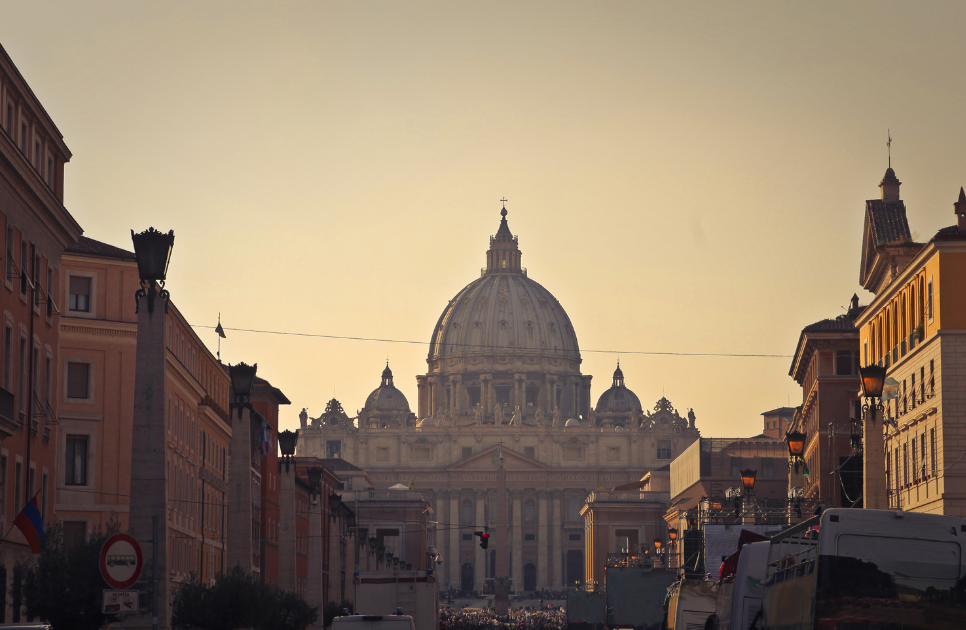
Your Guide to Navigating Rome During the 2025 Jubilee: Tips for Expats and Visitors
The 2025 Jubilee is a significant Holy Year in the Catholic tradition, occurring once every 25 years. Here are the key points: 1. Theme: The official motto for the 2025 Jubilee is “Pilgrims of Hope.” Pope Francis emphasizes hope as a central theme, encouraging believers to experience grace through pilgrimages, indulgences, and living testimonies of […]
Coronavirus: a new decree signed overnight by the Prime Minister Giuseppe Conte and published in the Official Journal contains more stringent measures to contain the spread of the virus in Lombardy and in 14 other provinces where the number of infections are greater.
A series of other measures are valid throughout the national territory. Compared to the initial draft, which began to circulate yesterday evening, there are 14 provinces and not 11 provinces, in addition to Lombardy, affected by more rigorous measures to contain the infection. These provinces are Modena, Parma, Piacenza, Reggio Emilia, Rimini, Pesaro e Urbino, Alessandria, Asti, Novara, Verbano Cusio Ossola, Vercelli, Padova, Treviso and Venezia. The measures stated in the decree are valid from today, March 8, until April 3.

RED ZONE MEASURES (Article 1 of the decree of 8 March 2020)
It is forbidden to enter and exit
Travel in and out of Lombardy and the 14 provinces stated above is prohibited. One can only move for emergencies or "proven" work needs, which must however be authorized by the prefect. Absolute ban on mobility for those who have been in quarantine.
Schools closed until April 3 - The teaching activity for schools of all levels, universities and academies is suspended until April 3.
Bars and restaurants open from 6 to 18 - The decree states an opening hours allowed for restaurant and bar services, from 6 to 18, provided that a place is able to comply with the "obligation" to ensure the interpersonal safety distance of 1 meter in the premises, with the sanction of suspension of the activity in case of violation. The suspension of exams for a driving license is also ordered.
Closed gyms and swimming pools. Derogation for games behind closed doors
The decree also establishes the closure in Lombardy and in the 14 provinces mentioned above of all gyms, swimming pools, spas and wellness centers. Outdoor sports competitions are allowed only behind closed doors (no fans). Shopping centers will have to be closed but only on the weekend. Other commercial activities, other than catering, may remain open on condition that they are able to guarantee a distance of one meter between customers. Instead, museums, cultural centers and ski resorts are closed. Contests are also suspended.
No weddings or funerals. Cinemas and theaters are closed
Civil and religious ceremonies, including funeral ceremonies, are suspended. All organized events are also suspended, as well as events in public or private places, including those of a cultural, recreational, sporting and religious nature, even if held in closed places but open to the public, such as large events, cinemas, theaters, pubs, schools dance halls, game rooms, betting rooms and bingo halls, discos and similar places.
Holidays
Whenever possible, employers are advised to encourage the use of ordinary leave or holidays by their employees.
VALID MEASURES IN THE REST OF ITALY (Articles 2 and 3 of the decree of 8 March 2020)
Schools are closed until March 15th
The teaching activity for schools of all levels and universities remains suspended until March 15th. Educational trips and school trips are suspended until April 3.
Cinemas, theaters and museums are closed
Throughout the whole national territory, the suspension of cinematographic, theatre events and events and shows of any nature "carried out in every place, both public and private". Opening of museums is suspended. The Municipality of Rome announces that it has ordered the closure of all museums, theatres and all places and institutes of culture.
Closed pubs, discos and bingo
Pubs, dance schools, game rooms, betting rooms and bingo halls, discos and similar clubs are suspended.
Bars and restaurants, gyms and swimming pools are open but with an obligation to keep distance of 1 meter between customers.
The managers of catering businesses can continue to keep the premises open, provided that they guarantee the interpersonal safety distance of at least one meter. Same goes for gyms and swimming pools, which can remain open as long as the visitors are guarantee safety distance from each other.
Limit travel
Among the preventive measures, art. 3 point C reads: "It is recommended to limit, where possible, the movement to strictly necessary cases".
Prohibition of staying in emergency rooms
Patient carers cannot stay in the emergency room waiting. Access of relatives and visitors to hospitals is also limited.
Prohibition of mobility for quarantined individuals
Even in the rest of Italy who is in preventive quarantine or has tested positive for the virus cannot move from home.
No civil and religious ceremonies, including funerals
Weddings and funerals are also suspended throughout the country.
Medical congresses suspension
Conferences, meetings and events involving healthcare personnel are suspended.
Prison visits
The decree provides for people in prisons to carry out the visits not in person but by telephone or video.
Holidays
As in the red zone, same goes for the rest of Italy, whenever possible, employers are advised to encourage the use of ordinary leave or holidays by their employees.
Public transport and sanitation of vehicles
Public transport companies will have to take extraordinary measures to disinfect their vehicles.
Communicate to ASL (national heath care company) if you come from the red zone
Anyone returning to Italy from countries at epidemiological risk must communicate it to the competent ASL office. But also those who have passed through the red zones in the last 14 days (article 5, point 2).
THE SANCTIONS
Failure to comply with the decree is punished according to the article 650 of the Criminal Code, as required by the law of 23 February, i.e. with the arrest of up to 3 months and a fine of up to 206 euros.
Original article in Italian and the PDF of the decree you can read here.

The Palio dell’Assunta: Siena’s Historic Horse Race
The Palio dell’Assunta in Siena is a historic and vibrant horse race held annually on August 16th. This event, deeply rooted in medieval traditions, takes place in the picturesque Piazza del Campo. It is one of the two Palios held in Siena each year, the other being the Palio di Provenzano on July 2nd. What […]

Ferragosto in Italy: What It Is and How It’s Celebrated
Ferragosto, celebrated on August 15th, is a significant public holiday in Italy that marks the height of the summer season. This ancient holiday has deep roots in Roman history and is a time when Italians come together to enjoy festive activities, travel, and communal gatherings. Understanding Ferragosto provides a window into Italian culture, traditions, and […]

Explore The Roman Countryside: A Summer Hike In Castel Gandolfo
Guest Article written by Sal from Nature of Sal For a refreshing escape from the city heat, expats can explore the picturesque trails of Castel Gandolfo. Nestled in the Alban Hills, this charming town offers stunning views and a serene hiking experience. Discovering Castel Gandolfo Castel Gandolfo is famous for its papal palace (after all, […]

How to Benefit from Italy’s 7% Tax Rate for Foreign Pensioners
Optional Regime for Foreign Pensioners – What It Is Overview Individuals receiving pension income from foreign sources who transfer their tax residence to Italy can benefit from an optional tax regime. This regime is available to those moving to specific municipalities in Sicily, Calabria, Sardinia, Campania, Basilicata, Abruzzo, Molise, and Puglia, with populations not exceeding […]
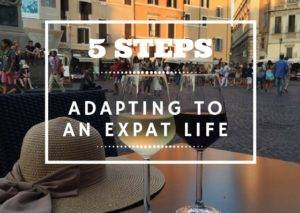 5 Steps to Adapting to Life as an Expatriate
5 Steps to Adapting to Life as an Expatriate
Everyone Goes Through the Five-Stage Cycle of Cross Cultural Adjustment
Expatriate Amy Hart, a North Carolina native who has lived and worked for 11 months in Munich, Germany, helps us to differentiate among the five different stages of the adjustment cycle.Everyone who moves to another country goes through a cultural adjustment cycle. Some take longer to go through the cycle than others.
1. Honeymoon Stage
At first stage everything in Hart’s her new surroundings was profoundly exciting and interesting. She had the feeling of a dream finally coming true and being in the middle of a great adventure. Just like a honeymoon, the bliss of beginning a new life can be rose-colored, happy, and hopeful for most expatriates.
2. Culture Shock
After six to eight weeks Hart moved into the culture shock stage. “Overall, I hated the feeling of not being independent. It’s as if you are a child again. Your personal freedom is suddenly taken away from you,” said Hart. It’s typical at this stage to physically feel that something is not right.
Hart often complained about headaches and stomach upsets. She felt tired and couldn’t concentrate on her work. Her sleeping patterns changed as well. She felt homesick and as if she was living with one foot in her American culture. This stage lasted for about another eight weeks.
3. Initial Adjustment Stage
After the culture shock period Hart went into what we call initial adjustment stage and became able to connect with local people in social and business situations. Though she was still missing her home, she gained self-reliance. Being needed in her company helped her feel better.
It was hard for her to realize that she then had to go through another stage of negative feelings.
Pennsylvania expatriate Kelly Payne lived and worked in Germany and Japan. She found it easier to enter this stage of initial adjustment when she learned how the ways of relaxing in her new host country differed from her own.
North Americans are active and try to crowd as many activities into an hour as possible. Wasting time is wasting money. In cultures where there is less emphasis on competition, people are able to let time “fill itself.” They place more emphasis on quality of actions than quantity of actions.
During the initial 40-minute subway rides to work in Germany, Payne felt the urge “to be doing something.”
“When I forgot to take my book or my walkman with me, I felt so useless just sitting in the subway. It took a while until I learned not to feel guilty when I just enjoyed watching people or letting my mind wander,” said Payne.
4. Mental Isolation
The initial adjustment stage is followed by another wave of integration ups and downs.
During this stage Hart really needed support and help from her friends and co-workers. She felt anger toward the host culture and doubt about her decision to live in Europe. “Maybe the people back home are forgetting about me,” said Hart.
She complained about the fact that everything is “verboten” (forbidden) in Germany and that the food was different. People were staring at her in a way she was not used to. “I sometimes felt as if I had an imaginary American flag on my forehead. People just knew even before I spoke. “I got the ‘you’re different’ type of look,” said Hart. She lost motivation to continue learning German, and you could tell a difference in her personality. The sparkles in her eyes were dimming but her mind was expanding as she transitioned.
5. Acceptance and Integration
Finally, Hart entered the last stage of the culture adaptation cycle: acceptance and integration. She stopped trying to change the host culture and stopped making constant comparisons to her own American way. She developed strategies for everyday life in Germany. She was willing to take German classes again, tried to speak German to everyone in the office, and seemed to be more content and less moody.
“My sense of time was mixed up in my first months here in Germany. At a restaurant with my German friends, I felt strange when they kept sitting at the table after finishing dinner. I felt the urge to pay for the meal and leave. I was ready to go to another bar or cafè. I learned not to be in such a rush and to have dinner for two hours or more instead of 45 minutes. I began to let go of the feeling that having a tight schedule was important and productive.”
The key to overcoming cultural difficulties is being willing to look behind the façade of appearances and learn to understand the basic human emotions we all share. For individuals from different cultural backgrounds, the possible ways of perceiving the same event can differ greatly.
“You can only see what you know.” Learning this is the key to understanding.
DANIELA MONTABAUR works with Trust in Business (TiB), an organization that provides international companies and individuals with support when relocating to Germany.
Source: Transition abroad
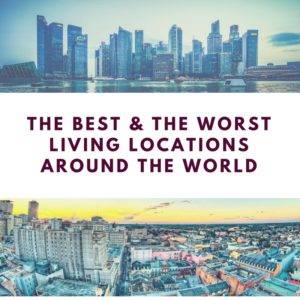 By Business Tech
By Business Tech
The Economist’s Intelligence Unit (EIU) has released its annual Liveable Cities ranking, listing the ten most and least liveable cities in the world.
The concept of liveability is to assess which locations around the world provide the best or the worst living conditions.
Assessing liveability has a broad range of uses, from bench marking perceptions of development levels to assigning a hardship allowance as part of expatriate relocation packages, the EIU said.
The Economist Intelligence Unit’s liveability rating quantifies the challenges that might be presented to an individual’s lifestyle in any given location, and allows for direct comparison between locations.
As was the case in 2016, global terrorism has kept the world on shaky ground, and has impacted the liveability in places like France and the UK, where attacks have taken place. Iraq, Libya, Syria and Turkey remain the subject of high-profile civil unrest and armed conflicts, while a number of other countries, such as Nigeria, continue to battle insurgent groups.
For the seventh consecutive year, Melbourne in Australia is the most liveable urban centre of the 140 cities surveyed, closely followed by the Austrian capital, Vienna – separated by only 0.1 percentage points.
Just 0.2 and 0.3 percentage points separate Canada’s Vancouver and Toronto (ranked 3rd and 4th, respectively), from Melbourne, and another Canadian city, Calgary, shares joint fifth place with Adelaide in Australia.
On the bottom end of the ranking are countries that have also long featured on the list for the wrong reasons, with war-torn Damascus in Syria taking the bottom spot, just below Lagos, Nigeria, which has slipped to second-worst of the 140 cities ranked.
The top ten and bottom ten are virtually unchanged, with only a few countries in the bottom improving their scores slightly.
The 10 most and least liveable cities in the world in 2017
| # | City | Country | Score |
|---|---|---|---|
| 1 | Melbourne | Australia | 97.5 |
| 2 | Vienna | Austria | 97.4 |
| 3 | Vancouver | Canada | 97.3 |
| 4 | Toronto | Canada | 97.2 |
| 5 | Calgary | Canada | 96.6 |
| 5 | Adelaide | Australia | 96.6 |
| 7 | Perth | Australia | 95.9 |
| 8 | Auckland | New Zealand | 95.7 |
| 9 | Helsinki | Finland | 95.6 |
| 10 | Hamburg | Germany | 95.0 |
| 131 | Kiev | Ukraine | 47.8 |
| 132 | Douala | Cameroon | 44.0 |
| 133 | Harare | Zimbabwe | 42.6 |
| 134 | Karachi | Pakistan | 40.9 |
| 134 | Algiers | Algeria | 40.9 |
| 136 | Port Moresby | PNG | 39.6 |
| 137 | Dhaka | Bangladesh | 38.7 |
| 138 | Tripoli | Libya | 36.6 |
| 139 | Lagos | Nigeria | 36.0 |
| 140 | Damascus | Syria | 30.2 |
Looking at Africa and South Africa, nine cities featured, but only the two South African cities were ranked within the top 100 – being Johannesburg (87th) and Pretoria (93rd).
African cities
- 87 – Johannesburg
- 93 – Pretoria
- 120 – Nairobi
- 124 – Lusaka
- 129 – Abidjan
- 130 – Dakar
- 132 – Douala
- 133 – Harare
- 139 – Lagos
The rankings are determined by assigning every city a rating of relative comfort for over 30 qualitative and quantitative factors across five broad categories: stability; healthcare; culture and environment; education; and infrastructure.
Each factor in a city is rated as acceptable, tolerable, uncomfortable, undesirable or intolerable. For qualitative indicators, a rating is awarded based on the judgment of in-house analysts and in-city contributors.
For quantitative indicators, a rating is calculated based on the relative performance of a number of external data points, the EIU said.
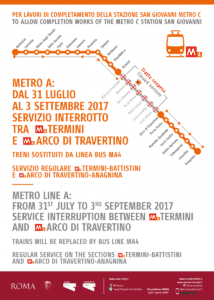 Metro A, will partially clost for work in progress from 31 July to 3 September, Service is interrupted between Temini and Arco di Travertino
Metro A, will partially clost for work in progress from 31 July to 3 September, Service is interrupted between Temini and Arco di Travertino
To allow for completion for San Giovanni station (Metro C), from July 31st to September 3rd service on Metro A is interrupted between the Termini and Arco di Travertino.
The service will continue as normal between Termini and Battistini and between Arco Travertino and Anagnina.
The Termini – Arco Travertino and vice versa are covered by the MA4 bus, which stops near each station.
The 7 stations affected are Vittorio Emanuele, Manzoni, S. Giovanni, Re di Roma, Ponte Lungo, Furio Camillo and Colli Albani direction Arco Travertino.
The MA4 line remains the same time as Metro A: first departure at 5.30, last departure at 23.30 (Sun / Thu) and 1.30 (Fri / Sat)
Link to original article in Italian
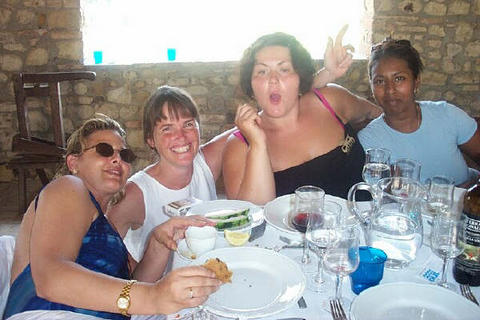
My first Expats’ photo in 2002
I like living in Rome but I don’t think I would like it in any other part of Italy!
I am Patrizia from upstate New York now living in Rome. My parents were both from Caserta, Italy and immigrated to the US when I was only an infant. I was an Expat since I was a year old.
Why Italy?
I guess it was destiny!! My mother always wanted to return to her home country and wasn’t able to do that due to a quick illness and sudden death. Our move back was canceled and we stayed in the US. I always remembered my mom talking about Italy as if it were paradise. I guess in a strange way I am fulfilling her dreams. Doing that I have learnt more about my mother and her culture.
Likes/dislikes about Italy and the Italians?
I like living in Rome but I don’t think I would like it in any other part of Italy. I have traveled and lived in other places but something draws me back here. The beauty of the city, and the nightlife, healthy lifestyle.
Has your life style changed since you moved to Rome? If yes, how?
I have been here so long that I am not sure what my old life style was 16 yrs ago 😉 I eat better and more picky about what I have. I have the convenience of having a car in the driveway or find easy parking. I adapted to things in Rome now. I am less materialistic but picked up a few superficial behaviours as well.
What is the the first thing you do when you go back to your home country?
Visit family of course, then find social networks and make new connections 😉
Does Italy/Rome seem multicultural?
Good question – I can say it is MultiCultural among those that have lived somewhere besides Italy all their lives. Rome has a meetup for foreigners and locals to meet everyday of the week. On some days there are 2 meetups for a Cultural or Language Exchange. So yes Rome is very multicultural.
Do you feel yourself integrated?
I have integrated with life here. I don’t freak out on small things. I don’t have a cappuccino after 11am anymore 😉 I dress not to stand out and put my flip flops in the trash. I sit in the post office for hours and don’t complain about it.
Could you tell us a few words about your group Rome expats?
I moved here in 2000 and in 2001 I started on a forum Expats living in Italy and there weren’t many English Speaking Expats that had access to internet so it was harder than to connect, but it was a small forum and we helped one another with information. In 2007 I started using other social media and suddenly I had a website and over 2 thousand members waiting for a meetup. We used to meet up 2 times a week for years but now it’s just once a week. With the emails coming in and managing such a large group, we have less meetups and more online help. 16 years later we have over 9 thousand members! Have a look at our video here.
Have you ever experienced any cases of discrimination/racism in Italy?
Yes… a few times in public with unpleasant remarks. I just ignore it.
Advice to a new expat in Rome? 😉
I don’t think I would have made here without a good network. I have a big network of Italian and Expat friends. It’s a referral system here in Italy. I see lots of Expats that will come to meet up and make friends with others that are living here a short time. I’d say try to make connections with those that have lived here about a year or even more.
 Anthony Majanlahti shares his story
Anthony Majanlahti shares his story
My experience of getting my residency is not the most difficult one I’ve heard of. Refugees have it worse, in fact just about everyone who isn’t an EU citizen has it harder. I can only tell my own story.
I was born and raised in Canada, of an English mother and a Finnish father. I’m a historian and writer about Rome, and obviously there’s no better place for me to live and do my research than here. However, for many years I lived here very hazardously, never sure if, once having left the country, the authorities would let me back in. I will draw a polite curtain over the stress of my life here as an extracomunitario. Temporary permessi di soggiorno for the purposes of study would expire, and have to be renewed, always from the Italian Consulate in Toronto, because they wouldn’t do it from Italy. So back I would go. And that kind of permesso didn’t give the right to work.
A few years ago, my father let me know that Finland had changed its laws to permit the children of people born in Finland to claim Finnish citizenship, probably because Finland’s population growth is negative at the moment. I didn’t have any EU citizenship rights through my mother, because the British changed their citizenship law: since I hadn’t been put on some embassy list before I was 18 years old, I had no right to British citizenship. However, now I suddenly had the right to Finnish and therefore EU citizenship. I jumped at the chance. After a surprisingly friendly and easy series of steps, I found myself clutching my prize, an EU passport. Now finally I couldn’t get sent back to Toronto.
At this point I wanted to go all the way and get my residenza in Rome. But I was perplexed. The information available online seemed contradictory and incomplete, and who knew whether or not the sites had been updated. Yet at the same time I didn’t want to go and ask anyone official – years of living dangerously had taught me an innate resistance to coming to the attention of the Italian authorities. I lived in a sort of semi-legal limbo for a long time.
My first piece of concrete advice is: if you have an EU passport, but no job, don’t be scared. There are a bunch of helpful organs ready to give you various pieces of information. I went to discuss the matter with the CGIL immigration assistance office on via Buonarroti 51, and they were very nice and gave me a lot of advice. It was also free. There was another agency of another big union, the UIL, whose offices are at via Cavour 108, near Santa Maria Maggiore, and they were even more friendly and less crowded. They too offer help and advice for free.
If you’re an EU citizen you don’t need to mess around with permessi di soggiorno or carte di soggiorno, no matter what the Ministry website says. What you want to establish is your residenza. With that, you can get your identity card and your health card, and with those pieces of identification you have official existence in Italy. You can even get a job.
Second, and this is a bit strange, but every different municipality of Rome has different requirements. As I live in Municipio I, Centro Storico, I am describing what my experience is with them. If you live in the historic centre, you are in Municipio I and you have to go down to the huge drab Fascist-era Anagrafe or Public Record Office on via Petroselli, down past the Theatre of Marcellus toward piazza Bocca della Verità. If you live in a different Municipio, check their website to see how their requirements differ: they won’t be significantly different, in any case.
Here is what you need, as an EU citizen without a contract or a job, to get your residenza:
- You need a codice fiscale, officially issued by the Agenzia delle Entrate or Tax Agency. The main Rome office is in Trastevere, on via Ippolito Nievo, 36. Getting this is easy, just turn up with your passport and fill in a bunch of forms.
- A bank statement from your Italian bank account. You have to have one of these – some banks offer accounts for foreigners. In any case, open a bank account and make sure you have the “minimo sociale” in there, which is some sort of minimal cash level to show that you won’t immediately need to sleep on the street. The amount in 2011 was €5,424.90. You don’t have to show tax documents from your home country, just a simple bank statement, as long as it’s from an Italian account and is recent.
- Your EU passport, obviously. Plus about three photocopies of it. Actually, photocopy everything, because you don’t want to find out something’s missing once you’ve been waiting for hours at the Public Record Office.
- Health insurance. I had private health insurance from Canada but you can also buy a private health plan here. You need a copy of your plan, preferably in Italian but I got away with mine in English, and several photocopies of it.
- A copy of your rental contract, or a letter from the person you are subletting from, stating that you are living there as a guest (the state doesn’t need to know you’re renting a room and won’t check if money is changing hands), along with that person’s rental contract and photocopies of that person’s identity card. Several copies of this, too.
- The Public Record Office wants to know if you’re married or single. This can be a bother to prove. For instance, I have never set foot in Finland so I was worried that the Finnish authorities couldn’t help, because as far as they know, I have seven wives and twenty-six kids. I emailed them, got a helpful email from them in English and another email address in Helsinki to write to. I wrote there and they wrote back that not only could they provide me with a “documento di stato civile”, a document proving my civil status (single), but they could send it to me IN ITALIAN. The helpfulness of the Finnish authorities almost made me cry. When I asked about how much it cost, they said they would send an invoice and I could pay upon receipt. It felt so un-Italian to be trusted like that by the state. I felt a surge of Finnish nationalism. As it turned out, though, the nice lady at the Rome Public Record Office just left all that stuff out because the document hadn’t arrived yet, and so it didn’t end up mattering. But that seemed like a matter of personal discretion on the part of the public official, so better be safe than sorry. Get some sort of document attesting to your single or married status.
- The Italians also want to know where you used to live, with some sort of official document from your home country stating your old address. But again, I didn’t have anything of the sort so I gave my mother’s address in Toronto and the nice lady at the Public Record Office just entered it in without complaint. It would be better to have something, like a letter from your home government with your name and address on it.
- Now, at this point you need either your job contract, with your last paycheck, or the dreaded partita IVA, the service tax code for independent taxable entities. The IVA is rather like the VAT in Britain or the goods and services tax in Canada, and having the partita IVA means the government expects you to pay it yourself out of your earnings. It has been raised to 21%, which is on top of your income tax of course. Since I have no contract, I had to get the partita IVA. Getting the partita IVA is super easy, rather like getting the codice fiscale which is another tax code. You just have to go to a commercialista or business manager (there are tons all over Rome and they can all do it for you), or ask the CGIL’s commercialista to do it for you, for a fee of €50. You present your passport, ask for a partita IVA, and the commercialista will ask in what sector you work. I said I worked as a translator and in cultural events, and the relevant code was soon found and entered. After about a week, the commercialista will email you your partita IVA. Everyone complains about the partita IVA. It has been described as “like having a child, but without the joy”. Apparently you have to pay an estimate on the tax that you expect to make in the next quarter, but you have to pay it this quarter. I haven’t quite figured it out. The system that was in place until January 1 of this year was called, somewhat slightingly, “per contribuenti minimi”, for minimal contributors, and it meant that if you made less than €30,000 a year (ha! I dream of €30,000 a year!) you didn’t have to go through all that rigmarole, and in fact you didn’t pay the IVA on your services at all, but the body paying you just made a “ritenuta d’acconto” or kept back 20% of what they were paying you, so they were paying the IVA and all you had to do was pay your income tax without worrying about it. Anyway it would seem that Monti’s new tax scheme has eliminated that tax program for “contribuenti minimi”, so I am in breathless anticipation to find out what is to become of me, taxwise. But. For our purposes, all you need is the partita IVA, and you can get it without much trouble.
- You also need two “marche da bollo” or government stamps, €14.62 each, which you can buy from any tabacconist’s, and two other government stamps, €0.52 each, which you can buy only from the “Cassa comunale” or City Government Cash Desk, on the first floor of the Anagrafe on via Petroselli. While you’re up there, buy the form (“modulo per la carta d’identità”) from the same desk, for €5.42. It saves you another trip up there later.
- Get some passport-sized or specifically carta d’identità-sized photos of yourself from a photo booth or photographer. Again, you won’t need them right away, but you may as well take care of it beforehand.
Make sure you have copies of everything! The Anagrafe will want the copies to keep, and will want to look at the originals, so bring it all with you.
The adventure really begins once you get to the at. It is said to open at 8.30, but by 8.30 the entrance is already crammed with a mass of people blocking your way. Sometimes someone has already made a makeshift numbering system and giving out little scraps of paper saying you’re number 16 or whatever. That makes the entrance into the Anagrafe at 8.30 slower. In any case, Bring a good book and your iPod, because chances are . Since the Anagrafe is only open in the morning, arriving after 8.30 is pointless. The bureaucracy is not fast.
Once you’re inside the Anagrafe, you will want to make your way to your , up some steps, into a large gloomy hall where you will have to decide what kind of service you want, like at the post office, and press a button to get a waiting number. You will want whatever the button is that says “”. There will probably be a helpful staff member to press the button for you if you are perplexed. However, at that point you are on your own. If your number isn’t immediately going to be called, you can exit the hall, go get a coffee and croissant at the bar inside the Anagrafe on the other side of the main entrance, and go upstairs to the Cassa comunale and buy your “” and the form (“”) for the identity card. Having done that, you will feel a pleasant sense of being armed and ready to do battle with the bureaucracy.
When your number is finally called (pay attention to the screen!), you will be brought into an office with a hopefully kindly functionary behind a desk who will ask to see your documents, may ask you questions, and will fill in a bunch of information on the computer. This functionary will tell you if there are pieces missing from your documentation – if there are, you will have to go through all of this again twice, so try to avoid missing out anything. At the end, having taken your photocopies of everything, the functionary will issue you with a wide computer-printed strip of paper, the “fascia”, which serves as a sort of interim identity document, saying in effect that your application for residenza is being processed. (You can already go to your local health authority with this “fascia” and sign up, but I waited til I had everything sorted out.) You need to bring this “fascia” back with you to get your identity card.
At this point the nice lady functionary told me, “Now all you have to do is wait for the police to come and check that you live where you say you live.”
“What?”
“Yes, you have no idea the kind of scams that people try to pull. Make sure you have your rental contract on hand and be at home when the policeman calls.”
“When will he come?”
“Oh, not within the next three weeks, I’d say,” said the functionary cheerfully. It was August. “You can certainly go on holiday without worrying.” This was all starting to look a bit haphazard and I got worried.
“What if I’m not there when he arrives?”
“Don’t worry, you’ll just have to take your rental contract and go to his office and show it to him.”
“But how is that different from showing it to you here, as I am doing now?”
“Because I am not the police,” she replied gently.
“And then what happens? Does the policeman give me a document that I bring back to you?”
“Oh, no!” she said. “The policeman sends a communication to us here, and we process it, and you come back and line up and get your identity card.”
“But how will I know when you get the policeman’s communication?”
“It usually takes about ten working days from when you see the policeman. Come back then.”
Well, I took her at her word, only to find that the police had passed by to see me when I was gone. I went to the police station on viale Trastevere, just past piazza Sonnino and before the start of via di San Gallicano, taking the piece of paper left with my concierge that gave the date and time that I should present myself at the policeman’s office. I noted that there were only two days a week when he could be found at his office, for precisely one hour, around lunchtime. I went with my rental contract, was ushered in immediately (there was no one else waiting), and a weary police officer filled in a form and glanced at my contract, and said “Congratulations. As far as the police are concerned, you are now a resident of Rome.”
“How long do I have to wait before I go back to the Anagrafe and apply for my identity card?” He laughed cynically. “All I can say is, this form will leave my office tomorrow. After that –” he spread his hands — “maybe you should wait a month or two.”
“But they told me ten days!”
“OK, OK. I can only tell you that my job ends when the paper leaves my office.”
“Well, thank you very much.”
“Welcome to Rome,” he said, already looking at another piece of paper on his desk.
I decided to wait two weeks, then risk it. This time I was smarter and got to the Anagrafe before 8 AM, and there were only about 20 or so people in front of me. I waited about 45 minutes, in high anxiety, before my number came up. I had brought my envelope with all my documents, originals and photocopies, including the “fascia” they’d given me last time. I went back into the office behind the counter, and a different functionary, but still very nice, confirmed that they had, indeed, received confirmation from the police that I was resident where I said I was, and that they could issue the identity card right away, especially since I already had the “modulo” (the form) and the photos. I handed my “fascia” over to her. After so much time and anxiety and effort, I could almost not believe it. But she put the blank identity card paper into the special printer and printed it out, then affixed one of my photos and stamped it with an official imprint. She then printed out a page entitled “ATTESTAZIONE DI REGOLARITA’ DEL SOGGIORNO PER I CITTADINI DELL’UNIONE EUROPEA” which stated that I, Anthony Majanlahti, born in.., resident in via…, of Finnish citizenship, “E’ REGOLARMENTE SOGGIORNANTE IN ITALIA”, “is staying in Italy according to the rules”. She affixed two of the “marche da bollo”, one of each kind, to one copy, and did the same to an office copy.
I left the Anagrafe with my carta d’identità, one of the old-style paper ones (“Some of the other Municipi give you the plastic card with the smart chip in it,” the functionary told me, “but it’s not free. It costs the earth!”), and couldn’t stop looking at it as I staggered up the via del Teatro di Marcello. I soon found myself in largo Argentina, and I went into a tobacconist’s to ask if I could buy a plastic cover for the identity card. “It’s my first identity card! I’m a legal resident of Rome at last!” I told the tobacconist, rather deliriously. To celebrate, he gave me the plastic cover for free.
From that point on, it was easy to get signed onto the medical system. I was in the Primo Distretto Sanitario of the ASL Roma A (which coincides with the Municipio I – check which yours is at their website, www.aslromaa.it), at via Luzzatti, 8, near piazza di Porta Maggiore. I went there with my documents, including my carta d’identità, and they filled out a quick form, took some photocopies of my passport and carta d’identità that I had already made just in case, and printed out a dummy version of my health card which would have to serve until the real one arrived by mail, a month or so later. I chose a doctor from a list of doctors near my apartment, and that was that. The real card arrived a month later and I cancelled my private health insurance. I was in the system.
Have a story to share that will help others living and working in Rome to become legal? Get the proper documents needed to make life easier? Please email us at [email protected]






